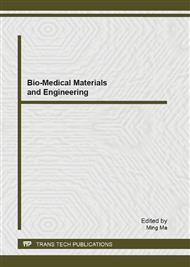p.182
p.186
p.192
p.198
p.206
p.211
p.215
p.221
p.228
Effects of Shaking Frequency on Growth and Adhesion Behaviour of Streptococcus mutans
Abstract:
Objective: To study the adhesion of streptococcus mutans (S. mutans) to two dental restorative materials and the growth of S. mutans in shaking culture with different frequencies. Methods: The specimen made of acrylic resin and Co-Cr alloy were put into culture medium with S. mutans and incubated respectively in shaking condition with different frequencies for 24h. The amount of S. mutans on the surface of specimen and in the culture media was determined by the clone forming unit (CFU) counting method. Results: When the frequency exceeded 60 rpm in acrylic resin groups and 30 rpm in Co-Cr alloy groups , the adhesive microbial amount declined with the increasing of shaking frequency . When the frequency was between 0¡«90rpm, the amount of in the culture media ascended with the increasing of shaking frequency , but decreased when the frequency increased beyond 90 rpm . Conclusion: When the frequency exceeded a certain level, the adhesion of S. mutans on the surface of two dental materials and the number of bacteria in the culture negatively correlated with the frequency, which implies that oral functional movements may lead to reduced microbes on the surface of dental restorative materials.
Info:
Periodical:
Pages:
206-210
Citation:
Online since:
August 2013
Authors:
Price:
Сopyright:
© 2013 Trans Tech Publications Ltd. All Rights Reserved
Share:
Citation:


